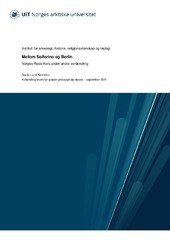| dc.contributor.advisor | Kristiansen, Tom | |
| dc.contributor.author | Rønnebu, Gaute Lund | |
| dc.date.accessioned | 2022-02-01T14:29:49Z | |
| dc.date.available | 2022-02-01T14:29:49Z | |
| dc.date.issued | 2022-03-04 | |
| dc.description.abstract | Den totale krigens karakter satte sitt klare preg på den humanitære virksomheten i Norge mellom 1940 og 1945. Men knappe ressurser og måten utnyttelsen av dem hvilte på sivilsamfunnets frivillige krefter, åpnet for at Norges Røde Kors under den tyske invasjonen og okkupasjonen av landet, kunne operere innenfor et humanitært «rom» organisasjonen selv kunne påvirke.
Norges Røde Kors måtte hele veien forholde seg til Quislings mistenksomme kollaborasjonsregime og en uforutsigbar tysk okkupant, samtidig som Røde Kors-bevegelsens grunnleggende prinsipper ble utfordret internt i organisasjonen. Sivilbefolkningens impuls til å slutte opp om det selvstendige, nøytrale og upartiske humanitære arbeidet i krisetider, og en utvidelse av aktivitetsporteføljen, skaffet Norges Røde Kors et bredt folkelig fundament i løpet av okkupasjonstiden. Men veien fra å hjelpe hverandre til aktivt motstandsarbeid kunne også være kort.
I et komplekst og dynamisk samspill mellom okkupasjonsregimet, organisasjonene og sivilsamfunnet, med folkeretten og de humanitære grunnprinsippene som sentrale omdreiningspunkter, utnyttet Norges Røde Kors mulighetene som det humanitære rommet åpnet for til å underbygge egen selvstendighet. Organisasjonen kom styrket ut av krigsårene, noe som også var del av en større utvikling rundt ideen om «humanitarianism». | en_US |
| dc.description.doctoraltype | ph.d. | en_US |
| dc.description.popularabstract | The character of the total war made its mark on humanitarian activities in Norway during the German occupation 1940–1945. However, resources were scarce and utilizing them largely depended upon the voluntary forces of civil society. This created the opportunity for the Norwegian Red Cross, during the 1940 campaign and the ensuing five-year German occupation, to operate within a «humanitarian space», which the organisation itself was able to influence.
The suspicious Quisling regime and the unpredictable German occupiers posed constant threats to the organisation, along with internal challenges to the basic Red Cross principles of independence, neutrality and impartiality. However, a general impetus to follow the basic humanitarian principles was reflected in a surge of the Norwegian Red Cross’ popularity and subsequent expansion of its tasks throughout the entire occupation. Nevertheless, for many members of the organisation there was a short distance from helping each other to joining the Norwegian resistance movement.
Through a complex and dynamic interplay involving the occupation regime, the organisations and civil society, revolving around international humanitarian law and the humanitarian ethos, the Norwegian Red Cross exploited the opportunities provided by the humanitarian space to substantiate its own independence. The Norwegian Red Cross emerged from the Second World War stronger than it was before it. This was also part of a greater development, where the idea of humanitarianism overall was strengthened. | en_US |
| dc.identifier.uri | https://hdl.handle.net/10037/23878 | |
| dc.language.iso | nob | en_US |
| dc.publisher | UiT Norges arktiske universitet | en_US |
| dc.publisher | UiT The Arctic University of Norway | en_US |
| dc.rights.accessRights | openAccess | en_US |
| dc.rights.holder | Copyright 2022 The Author(s) | |
| dc.rights.uri | https://creativecommons.org/licenses/by-nc-sa/4.0 | en_US |
| dc.rights | Attribution-NonCommercial-ShareAlike 4.0 International (CC BY-NC-SA 4.0) | en_US |
| dc.subject | VDP::Humaniora: 000::Historie: 070 | en_US |
| dc.subject | VDP::Humanities: 000::History: 070 | en_US |
| dc.title | Mellom Solferino og Berlin. Norges Røde Kors under andre verdenskrig | en_US |
| dc.type | Doctoral thesis | en_US |
| dc.type | Doktorgradsavhandling | en_US |


 English
English norsk
norsk
